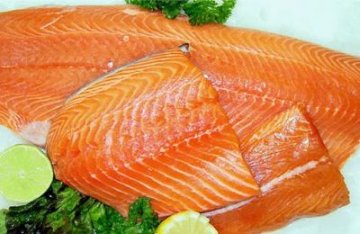Omega-3
"I really didn't know Omega-3 is fatty acids."
"I thought it's only a nutritive supplement!"
These are only a part of common responses of people who just have heard that the Omega-3 (or ω-3) is a member of the fats family.
The word "fats" may raise negative connotation in anyone of you.
Well, there is a good reason for that. In large amounts there is no doubt that fats are bad for you, but you will surprised to know that there are some kinds of fats you can't live without.
One of the important kinds among them is the ω-3 fatty acids.

The ω-3 can be found in foods including:
- Coldwater fish such as herring, mackerel, salmon, sturgeon, and anchovies.
- Walnuts.
- Seeds and oils of soya, hemp, flax and pumpkin.
- Leafy green vegetables such as broccoli, spinach, lettuce, green peppers and radish.
- Fruit such as blackberries, blueberries, strawberries, melon, lemon and guava.
It also helps protect us from several health problems.
- It reduces blood pressure levels.
- It helps prevent allergies.
- It reduces the risk of cardiovascular diseases.
- It promotes the healing from illness or injury.
- It helps balance blood sugar levels.
- It combats depression.
- It helps prevent certain cancers.
- It helps prevent attention deficit hyperactivity disorder (ADHD).

Another kind of fatty acid is the omega-6 which has a similar molecular structure, and can be found in foods such as eggs, poultry, cereals, vegetable oils, baked goods, and margarine.
But when omega-6's aren't balanced with sufficient amounts of omega-3, health problems such as cardiovascular diseases and thrombotic stroke can appear.
If both ω-3 and ω-6 are present, and in a good ratio, where the ω-3 has a bigger part than the part it used to have in the past, then we can reduce the chances to these health problems.
The typical American diet has a ratio of around 20 to 1. 20 ω-6's to 1 ω-3 and that is bad.
The ratio required, is the opposite direction - more parts ω-3 and fewer parts ω-6.
Though the most common source of ω-3 can be found in fatty fish, marine sources, seeds and walnuts, the average person may not be able to consume enough of what the body needs to make a significant impact on their overall health.
Probably you don't like fish (or choose not to eat it).
You can still get what you need from another source such as all kind of supplements.

Therefore it would be beneficial to include ω-3 supplements as part of your daily regimen along with a balanced diet.
The recommendation for omega-3 is 2 servings of fish a week, at 3 to 4 ounces per serving, that's well below the FDA's safe limit of 12 ounces per week.
According to the American Heart Association, those who are looking to protect their hearts should eat a variety of types of fatty fish (such as salmon, tuna, and mackerel) at least twice a week.
Those with heart disease should get 1 gram of omega-3's (containing both EPA and DHA) per day, preferably from fatty fish.
Before you take any vitamin or natural supplement, consult with your healthcare provider to see what he/she recommends.
|
Return from Omega-3 to Diabetes Articles |